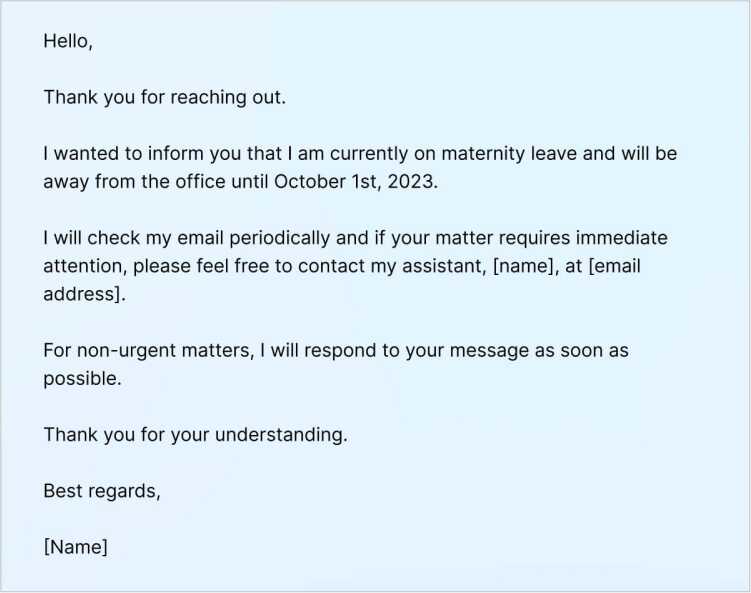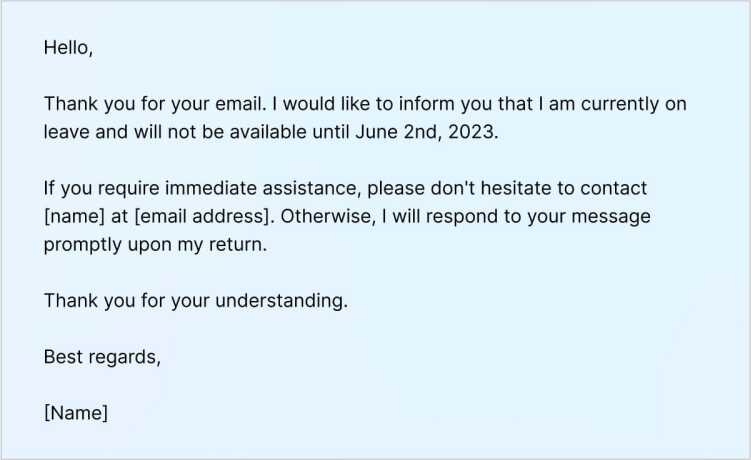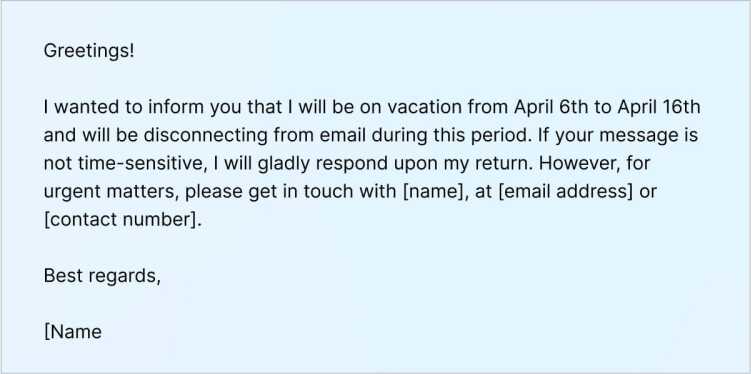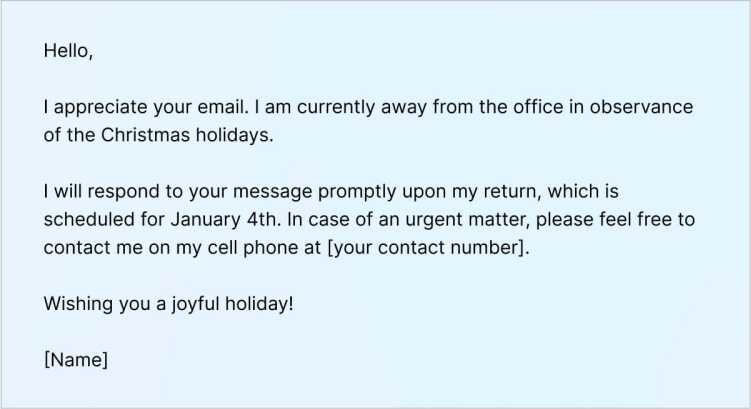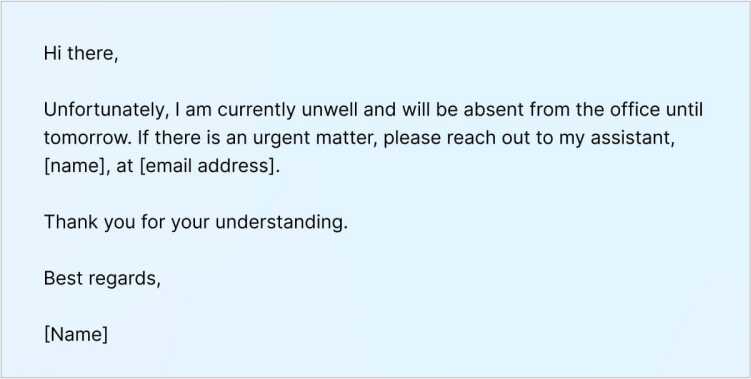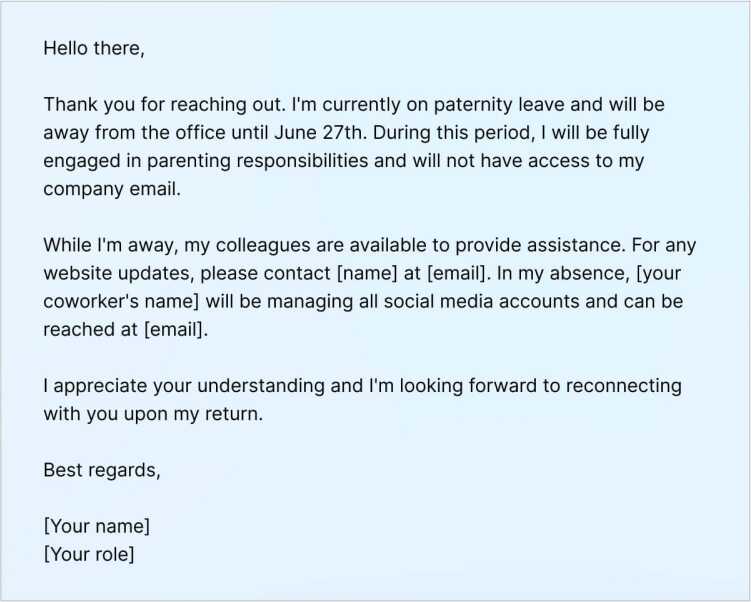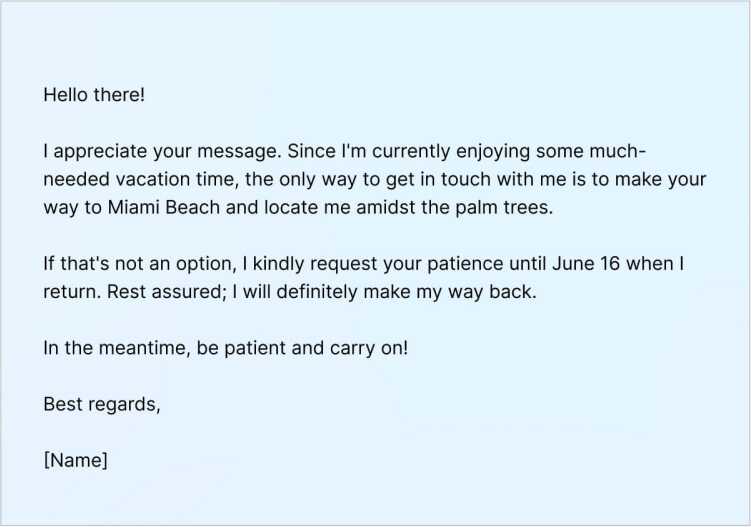At some stage, we all require time off from our workplace. Whether it’s for enhancing professional skills, recuperating from an illness, or relishing a deserved vacation, there are occasions when you will take days off and relish your personal time. And the business continues to function in your absence. So, it is your duty to guarantee the seamless operation of tasks even when you’re not present.
Here my suggestion will be to compose a professional out-of-office message, often referred to as an OOO message. This message informs your clients, colleagues, and contacts about your absence and directs them to seek immediate assistance if their needs cannot wait until your return. Crafting and implementing the out-of-office email is an excellent means of preventing any inconvenience while showcasing your professionalism.
Within this blog post, you will discover:
- The definition of an out-of-office (OOO) message
- The significance and relevance of an OOO message
- Step-by-step guidance on creating an impactful out-of-office message
- Furthermore, we have provided a collection of OOO message templates and examples to assist you in finding inspiration and creating your own message
Let’s Start!
What is an Out-of-Office Message: A Comprehensive Overview
An out-of-office (OOO) message is an automatic reply, usually sent via email, to inform others that you are currently unavailable. Apart from being considered polite in email communication, a basic OOO message fulfills two important roles: it helps set expectations and safeguards against feeling overwhelmed upon your return.
For 62% of clients and 31% of colleagues, email serves as the main mode of business communication. Given the widespread adoption of this method and the shared understanding of its importance, timely responses are expected by your clients and colleagues. Your out-of-office (OOO) email accomplishes the following:
- Maintain open communication channels during your absence.
- Acknowledges the needs of your contacts.
- Informs others about the reason for your absence, its duration, and provides alternative contact information in your absence.
In the current hybrid work environment, it’s not always evident to everyone that you’re away. By utilizing an automated response, you ensure that colleagues who work on shifts are informed and provided with the necessary support and resources to manage their schedules while you’re unavailable.
Additionally, OOO emails serve as a preventive measure against feeling overwhelmed upon your return to the office. Many individuals hesitate to take time off due to concerns about facing an excessive workload upon their return.
However, an OOO message redirects general inquiries to your coworkers and helps maintain a manageable inbox, mitigating the fear of being inundated with tasks upon your return.
When to Use an Out-of-Office Message: Essential Guidelines
In situations where you anticipate being unable to respond to emails for an extended duration, it is advisable to activate an automated reply.
Moreover, if you frequently handle time-sensitive matters that necessitate quick responses, you can utilize a temporary out-of-office (OOO) message on your workplace communication platform, such as Slack or Teams, to inform both colleagues and clients about your absence from your desk.
The reasons for implementing an OOO message include:
- Taking a vacation
- Attending a conference or workshop
- Going on parental leave
- Participating in a company event
- Having doctor’s appointments that occupy a significant portion of the day
- Taking a mental health day
- Being on sick leave
- Going on a business trip
- Taking personal leave
- Embarking on a sabbatical
How to Write an Out-of-Office Message
To begin, it is essential to identify and inform your backup contacts who will be available to assist customers in your absence. Meeting with your co-workers and effectively communicating your plans should be among your highest priorities. It is crucial that the person covering for you during your absence is not caught off guard by receiving unexpected emails. Approach this situation professionally and meticulously plan ahead; after all, you deserve a well-earned break.
Prior to your vacation, it is important to send a reminder to all your team members, notifying them about your specific absence dates. Additionally, ensure that your vacation is clearly marked on all internal company calendars.
People can get caught up in their own tasks and easily forget about irregular events. Even if you had previously mentioned your vacation plans, it’s possible that your colleagues may have overlooked or forgotten about them. Avoid potential issues by proactively reminding everyone, as miscommunication can be easily avoided in this situation.
Failing to clearly indicate the dates of your disconnection from work can result in your office co-workers and clients sending multiple emails, causing your inbox to become overwhelmed. This will make it significantly challenging for you to catch up upon your return.
Additionally, if you neglect to include the names and contact information of the co-workers who can assist during your absence in your outgoing message, your much-needed and enjoyable vacation time might interfere with specific projects within the company.
What to Add in Your Out-of-Office Message:
Here are some recommendations for essential elements to include in your out-of-office (OOO) auto-reply emails:
- Clear and Accurate Dates: Be sure to specify the exact dates of your time off. If you are reusing a previous OOO message, double-check and update the dates to ensure they are correct. Errors can easily occur when inputting numbers.
- Managing Expectations Upon Your Return: If you anticipate many messages awaiting your attention upon your return, it is crucial to set clear expectations. Inform your auto-reply recipients that there might be a delay in your response and that you will make your best effort to address all emails as soon as possible.
- Clarify the Reason for Your Absence: It’s important to communicate the purpose of your time off to prevent others from assuming you’ll be available for contact. When people are aware that you’re taking personal or vacation time, they are less likely to attempt to get in touch with you.
- Identify the Colleagues Who Can Provide Assistance: Provide the names, phone numbers, and email addresses of the co-workers who can temporarily cover your responsibilities. If you handle multiple areas or tasks, clearly specify each person’s area of expertise. This ensures that colleagues and clients know exactly whom to reach out to for assistance in each specific area.
What to Avoid in Your Out-of-Office Message:
When crafting and enabling your out-of-office message, it is advisable to refrain from including the following:
- Excessive Details: While it’s natural to be enthusiastic about your upcoming time off, there is no need to provide extensive specifics. Simply informing others that you will be unavailable is adequate.
- Attempting Humor When Professionalism is Necessary: It is generally best to avoid making jokes unless you are certain that the recipients of your message will understand and appreciate them. Otherwise, jokes can be easily misinterpreted and convey an unintended impression.
- Avoid Assuming Immediate Assistance from Colleagues: It’s impossible to predict how quickly your co-workers will be able to respond to emails while you are away. Therefore, refrain from promising immediate assistance in your absence. Allow them the flexibility to manage their workload and response times accordingly.
- Seek Permission Before Sharing Contact Information: Prior to including your colleagues’ email addresses and phone numbers in your out-of-office message, make sure to ask for their consent. They may have their own workload and commitments, including upcoming projects that could make them too occupied to serve as temporary substitutes.
- Beware of Typos: Your out-of-office message may reach anyone, from your manager to your top client. Avoid potential embarrassment by thoroughly proofreading your message for any errors before activating it. Careful attention to detail ensures a professional impression.
Simple Out-of-Office Message Examples: Samples for Your Reference
Chances are, you receive numerous out-of-office emails on a daily basis and are familiar with the information they typically provide. These emails can vary in tone, ranging from strictly professional and formal to light-hearted and humorous, depending on the circumstances. You can leverage these messages as an opportunity to strengthen your connection with your customers.
On the other hand, since most of your out-of-office emails are likely to be sent to recipients with whom you have regular communication, consider adding a personal touch. If you are confident in the level of familiarity you share with these individuals, you can include a brief personal anecdote, a funny note, or a joke. This allows them to form a more personal bond with you. Anyways here are some examples for your reference.
-
Out-of-Office Message for Maternity Leave
The duration of maternity leave can vary depending on the policies of each country and company.
Regardless of the length of your maternity leave, whether it’s 3 months or a year, using a professional maternity “away message” is a courteous way to inform others about your absence and set expectations for your response.
Now, let’s examine an example of an ‘Out-of-Office message for maternity leave.’
-
Out-of-Office Message with No Access to Email
If you prefer not to or are unable to check emails during your day offs, take into account the following example.
-
Out-of-Office Message for Vacation
Your vacation leave request has been approved by your manager, which is excellent news. Now, it’s time to compose a suitable out-of-office (OOO) message for your vacation. Make sure the tone of your reply aligns with the audience it is intended for. Here’s one example.
-
Out-of-Office Message for the Holiday
While you may assume that nobody will reach out to you during the holiday season, it’s important to consider that some individuals who don’t celebrate may still try to contact you. Now, let’s examine an example of a well-crafted out-of-office (OOO) message for the holidays that effectively manage expectations.
-
Out-of-Office Message for Sickness
If you need ideas for out-of-office messages during a brief sick leave, the following example can serve as a reference.
-
Out-of-Office Message for Parental Leave
Since your absence will be for an extended period due to your paternity leave, it is important to create an out-of-office (OOO) message that clearly communicates your unavailability via phone or email. Additionally, you should provide alternative sources of assistance.
-
Funny Out-of-Office Message
While it’s important for your out-of-office messages to maintain a professional tone, it doesn’t mean you can’t sprinkle in some humor. After all, humor has the power to bring people together and bridge gaps. But remember one thing! Such funny OOO messages you should send to your co-workers and colleagues who know you personally, not to your customers.
Here’s one example for you!
Setting Up an Auto Out-of-Office Message in Outlook: The Steps
Now that you’re familiar with the process of creating a compelling out-of-office message, let’s review the steps for setting up an automatic reply in Outlook.
- In the Outlook interface, locate the ribbon at the top and click on the “File” tab.
- From the dropdown menu, select ‘Automatic Replies (Out of Office).’
- On the ‘Automatic Replies’ screen, enable the “Send automatic replies” option. If desired, specify the date range for the automatic replies.
- In the lower section of the screen, ensure that you are on the “Inside My Organization” tab. Proceed to compose the message you wish to display as your out-of-office reply.
- Once you have crafted your message, click “OK.”
By following these steps, you will successfully configure your out-of-office message in Outlook.
Over to You!
How about you? Do you usually write out-of-office messages? If so, do you have any additional tips to contribute to our list?
Feel free to share your experiences and tips with us in the comment section below. We may include your insights in this or future blog posts. And if you enjoyed this blog post and found it helpful, consider sharing it with someone you think would also find value in it.

